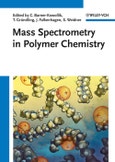Combining an up-to-date insight into mass-spectrometric polymer analysis beyond MALDI with application details of the instrumentation, this is a balanced and thorough presentation of the most important and widely used mass-spectrometric methods.
Written by the world's most proficient experts in the field, the book focuses on the latest developments, covering such technologies and applications as ionization protocols, tandem and liquid chromatography mass spectrometry, gas-phase ion-separation techniques and automated data processing. Chapters on sample preparation, polymer degradation and the usage of mass-spectrometric tools on an industrial scale round off the book.
As a result, both entrants to the field and experienced researchers are able to choose the appropriate methods and instrumentations -- and to assess their respective strengths and limitations -- for the characterization of polymer compounds.
Written by the world's most proficient experts in the field, the book focuses on the latest developments, covering such technologies and applications as ionization protocols, tandem and liquid chromatography mass spectrometry, gas-phase ion-separation techniques and automated data processing. Chapters on sample preparation, polymer degradation and the usage of mass-spectrometric tools on an industrial scale round off the book.
As a result, both entrants to the field and experienced researchers are able to choose the appropriate methods and instrumentations -- and to assess their respective strengths and limitations -- for the characterization of polymer compounds.
Table of Contents
IntroductionMASS ANALYSIS
Introduction
Measures of Performance
Instrumentation
Instrumentation in Tandem and Multiple-Stage Mass Spectrometry
Conclusions and Outlook
IONIZATION TECHNIQUES FOR POLMYER MASS SPECTROMETRY
Introduction
Small Molecule Ionization Era
Macromass Era of Ionization
Modern Era of Ionization Techniques
Conclusions
TANDEM MASS SPECTROMETRY ANALYSIS OF POLYMER STRUCTURES AND ARCHITECTURES
Introduction
Activation Methods
Instrumentation
Structural Information from MS2 Studies
Summary and Outlook
MATRIX-ASSISTED INLET IONIZATION AND SOLVENT-FREE GAS-PHASE SEPARATION USING ION MOBILITY SPECTROMETRY FOR IMAGING AND ELECTRON TRANSFER DISSOCIATION MASS SPECTROMETRY OF POLYMERS
Overview
Introduction
New Sample Introduction Technologies
Fragmentation by ETD and CID
Surface Analyses by Imaging MS
Future Outlook
POLYMER MALDI SAMPLE PREPARATION
Introduction
Roles of the Matrix
Choice of Matrix
Choice of the Solvent
Basic Solvent-Based Sample Preparation Recipe
Deposition Methods
Solvent-Free Sample Preparation
The Vortex Method
Matrix-to-Analyte Ratio
Salt-to-Analyte Ratio
Chromatography as Sample Preparation
Problems in MALDI Sample Preparation
Predicting MALDI Sample Preparation
Conclusions
SURFACE ANALYSIS AND IMAGING TECHNIQUES
Imaging Mass Spectrometry
Secondary Ion Mass Spectrometry
Matrix-Assisted Laser Desorption Ionization (MALDI)
Other Surface Mass Spectrometry Methods
Outlook
HYPHENATED TECHNIQUES
Introduction
Polymer Separation Techniques
Principles of Coupling: Transfer Devices
Examples
Conclusions
AUTOMATED DATA PROCESSING AND QUANTIFICATION IN POLMYER MASS SPECTROMETRY
Introduction
File and Data Formats
Optimization of Ionization Conditions
Automated Spectral Analysis and Data Reduction in MS
Copolymer Analysis
Data Interpretation in MS/MS
Quantitative MS and the Determination of MMDs by MS
Conclusions and Outlook
COMPREHENSIVE COPOLYMER CHARACTERIZATION
Introduction
Scope
Reviews
Soft Ionization Techniques
Separation Prior MS
Tandem MS (MS/MS)
Quantitative MS
Copolymers for Biological or (Bio)medical Application
Software Development
Summary and Outlook
ELUCIDATION OF REACTION MECHANISMS: CONVENTIONAL RADICAL POLYMERIZATION
Introduction
Basic Principles and General Considerations
Initiation
Propagation
Termination
Chain Transfer
Emulsion Polymerization
Conclusion
ELUCIDATION OF REACTION MECHANISMS AND POLYMER STRUCTURE: LIVING/CONTROLLED RADICAL POLYMERIZATION
Protocols Based on a Persistent Radical Effect (NMP, ATRP, and Related)
Protocols Based on Degenerative Chain Transfer (RAFT, MADIX)
Protocols Based on CCT
Novel Protocols and Minor Protocols
Conclusions
ELUCIDATON OF REACTION MECHANISMS: OTHER POLYMERIZATION MECHANISMS
Introduction
Ring-Opening Polymerization Mechanisms of Cyclic Ethers
Ring-Opening Polymerization Mechanisms of Cyclic Ethers and Carbonates
Ring-Opening Metathesis Polymerization
Mechanisms of Step-Growth Polymerization
Concluding Remarks
POLYMER DEGRADATION
Introduction
Thermal and Thermo-Oxidative Degradation
Photolysis and Photooxidation
Biodegradation
Other Degradation Processes
Conclusions
OUTLOOK








